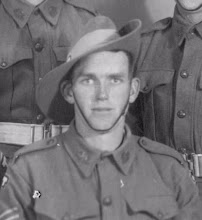
Monday, September 1, 2008
[Image] Bored Engineers are trouble

[Image] The barbed wire clothesline
[Image] Tommy got you covered
VX31704 Cpl. Warwick Brownrigg & his Thompson.
VX31704 Cpl. W. Brownrigg aims his American made Thompson sub machine gun out a firing slot in the sandbag defences of his position in the Red Line of Tobruk's outer perimeter.
Cpl. Brownrigg, of the 2/23rd Infantry Battalion out of Victoria, featured in a number of photos taken at the time by members of the Military History and Information Unit. In this one he has a rare Tommy Gun with a larger 50 round drum magazine inserted. It also has the fore grip fitted, which with the added weight of the larger magazine made it a necessity for semi-accurate firing.
Cpl. Brownrigg is listed as having been discharged from the Army on 22nd October, 1942. As his service record has not been digitised by the National Archives I am unable to say for certain why. I suspect that his discharge date being so close to the date of the Second Battle of El Alamein that he may have been so severely wounded that he was not expected to be able to return to service and thus discharged. At this stage this is nothing more than an educated guess.
image 020503 Australian War Memorial.
[Image] 25 Pounder at the Australian War Memorial
The 25 Pounder was the standard artillery piece of both the Royal Australian Artillery as well as the Royal Horse Artillery, the British Artillery Regiment, that aided the Australian Infantry with the defence of Tobruk during the siege by the Afrika Korps in 1941.
Several of these guns, along with countless crates of ammunition, were captured by the Germans at Mersa Matruh in Rommel's rapid advance towards Alexandria in 1942. These same guns were turned upon the 2/48th Infantry Battalion during the Battle of El Alamein with devastating effect. The 2/48th retook the guns within a short period of time and again set them upon the fleeing Germans.
All accounts from Tobruk that I have read all say that without the support of the Royal Horse Artillery the Siege of Tobruk would have been over very quickly. Tobruk was the perfect example of Australian Infantry and British Cavalry and Artillery working as one cohesive unit.
image courtesy of Robert Snewin. Used with permission.
This post is a direct reponse to the question asked by Douglas Chan who wanted to know what were the Royal Horse Artillery guns used during the Siege of Tobruk. I hope this helps Douglas. Good luck with your project!
[Image] German Vanity at Alamein

[Image] Anzac Day 2008, Tobruk, Libya.
[Image] 20th Brigade Colour Patches
 2/15th Infantry Battalion
2/15th Infantry BattalionQueensland.

2/17th Infantry Battalion
New South Wales.
These are the felt colour patches worn by the members of the 20th Brigade of the 9th Australian Division. The felt colour patch is worn on the upper outer sleeve of the tunic on both the left and right arms. They differ from other patches that were worn by other members of the AIF in the Second World War in that they are shaped like the letter 'T' whereas members of the 6th, 7th (except the 18th Brigade) and 8th Divisions wore a patch in the shape of a diamond separated into a top half colour and a bottom half colour.
The significance of the colour patches as worn by the 9th Division and members of the 18th Brigade of the 7th Division is that the shape has been varied from the AIF standard diamond to that of the letter 'T' in tribute to the Battalion's involvement in the defence of Tobruk. It was a badge that the Rat's wore with pride. When on leave everyone knew they were the one's who stopped Rommel in his tracks for so long.
The grey outline signifies the 9th Australian Division, the green border belongs to the 20th Brigade and the 'T' shape is in the individual battalion colours, the 2/13th was black, the 2/15th was purple and the 2/17th was white.
The changing of the colour patch's shapes, in recognition of the men involved in the Siege of Tobruk, has only ever been done this once in the entire history of the AIF.
This is one of the best indications of the significance of the action that the 9th Division was involved in at Tobruk was not lost on the Army. The Army changed nothing in recognition of deeds performed during World War One. This to me is one of the highest honours that the Army ever placed on the 9th Division.
colour patch images General Collection Australian War Memorial.














